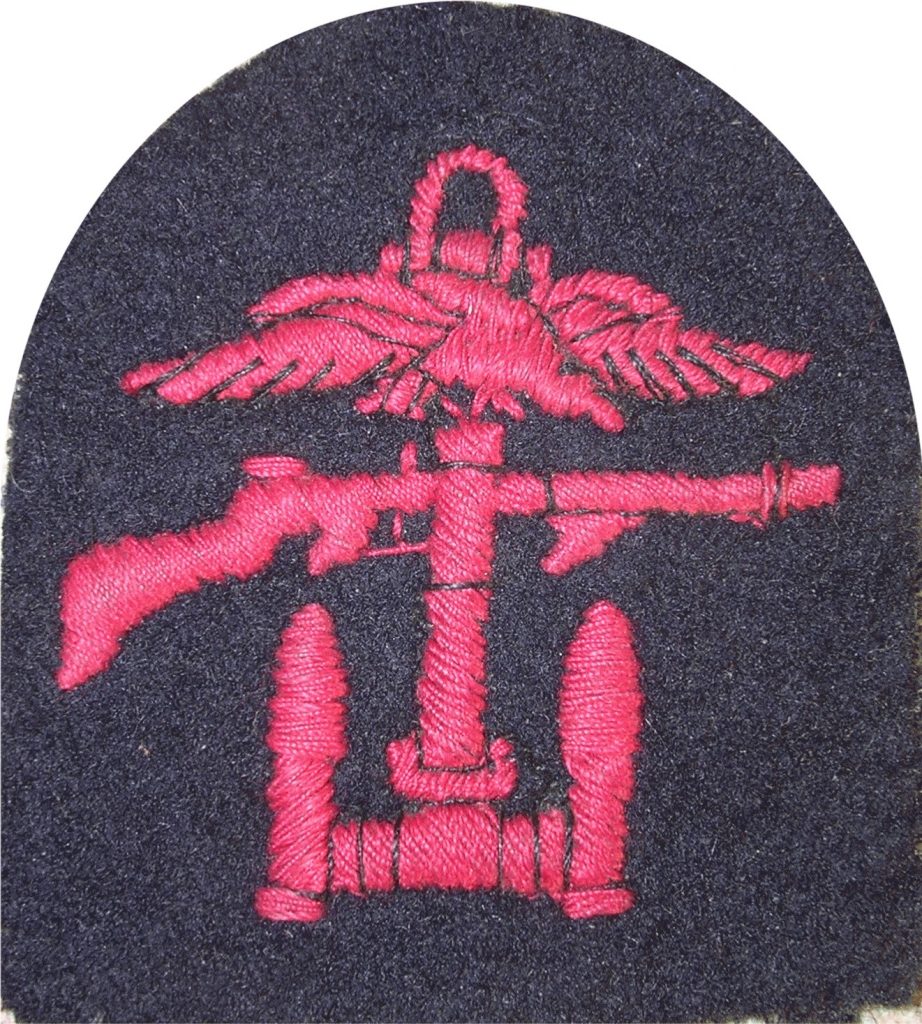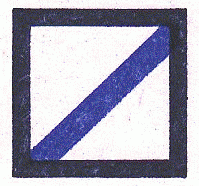August 1943 – The Re-Organisation of R.A.F. Beach Units in the U.K.
After the formation of the first R.A.F. Beach Units in the U.K. in May 1943, their organisation was reviewed and a directive was issued, dated 17th August 1943, that defined the organisation, function and training of R.A.F. Beach Units for future operations. 1
At this time, the U.K. raised Nos. 68 and 69 R.A.F. Beach Units were in the Mediterranean theatre of operations. Having taken part in the invasion of Sicily they were now in North Africa preparing for the landings in Italy, at Salerno. Back home in the U.K, Nos. 70, 71, 76 and 77 R.A.F. Beach Units were to be re-organised.
The re-organisation was made so as to conform to the Army beach organisation of a Beach Sub Area Headquarters controlling two or more Beach Groups.
Nos. 70 and 71 R.A.F. Beach Units were disbanded and immediately reformed as No. 1 R.A.F. Beach Unit, comprising a Headquarters section and Nos. 101 and 102 R.A.F. Beach Sections. The Unit H.Q. was to be the R.A.F. element with the Army Sub-Area H.Q. that controlled Nos. 5 and 6 Army Beach Groups; No. 101 R.A.F. Beach Section was to be the R.A.F. element with No. 5 Army Beach Group and No. 102 R.A.F. Beach Section was to be the R.A.F. element with No. 6 Army Beach Group. The parent station for No. 1 R.A.F. Beach Unit was R.A.F. Station Ayr, No. 13 Group, Fighter Command.
Nos. 76 and 77 R.A.F. Beach Units were disbanded and immediately reformed as No. 2 R.A.F. Beach Unit, comprising a Headquarters section and Nos. 103 and 104 R.A.F. Beach Sections. The Unit H.Q. was to be the R.A.F. element with the Army Sub-Area H.Q. that controlled Nos. 7 and 8 Army Beach Groups; No. 103 R.A.F. Beach Section was to be the R.A.F. element with No. 7 Army Beach Group and No. 104 R.A.F. Beach Section was to be the R.A.F. element with No. 8 Army Beach Group. The parent station for No. 2 R.A.F. Beach Unit was to become R.A.F. Station Ayr, No. 13 Group Fighter Command in place of the current units’ parent station which was R.A.F. Station West Kirby, No. 28 Group, Technical Training Command.
In addition, it was decided to form No. 3 R.A.F. Beach Unit comprising a Headquarters section and Nos. 105 and 106 R.A.F. Beach Sections. The Unit H.Q. was to be the R.A.F. element with the Army Sub-Area H.Q. that controlled Nos. 9 and 10 Army Beach Groups; No. 105 R.A.F. Beach Section was to be the R.A.F. element with No. 9 Army Beach Group and No. 106 R.A.F. Beach Section was to be the R.A.F. element with No. 10 Army Beach Group. The new unit was to form at R.A.F. Station West Kirby, No. 28 Group, Technical Training Command, which was to act as parent station initially.
Nos. 1, 2 and 3 R.A.F. Beach Units, September to December 1943
With the recently formed No. 3 R.A.F. Beach Unit being located at Dundonald its parent unit was changed from R.A.F. Station West Kirby to R.A.F. Station Ayr with effect from 10th October 1943. Prominent among the activities of No. 3 R.A.F. Beach Unit during the last months of 1943 was various elements of the Unit being attached to the R.A.F. Regiment Depot at Grantham for their 14 day Battle Inoculation Course.
No. 2 R.A.F. Beach Unit was located in Hampshire in September 1943, taking part in Exercise ‘PIRATE’ in October, when practise landings were made in Studland Bay. R.A.F. Station Tangmere became its parent station with effect from 1st October 1943 and then, from the beginning of December, R.A.F. Station Hurn became the Unit’s parent station.
No. 1 R.A.F. Beach Unit remained based in Scotland, with various parts of the Unit moving around for training. No. 101 R.A.F. Beach Section took part in Exercise ‘ROUNDABOUT I’ in December 1943, when landing of stores and equipment took place at Gullane, where the Beach Group Practice Camp was located.
The Beach Units were created under Technical Training Command but operationally came under the control of the Director of Movements. During the last months of 1943 it was agreed that the R.A.F. Beach Units involved in Operation Overlord would be placed under the control of Headquarters, 2nd Tactical Air Force. For administrative purposes they would come under the control of No. 85 (Base) Group when that unit was sufficiently formed, but operational and technical control would remain with 2nd T.A.F.
The reasons given for this were:
· Control by T.A.F. would enable the Beach Units to be kept in close contact with both the R.A.F. and Army formations with whom they were to operate.
· During the time the Beach Units were in operation, T.A.F. would be the Senior R.A.F. Formation ashore, and would therefore, of necessity have to control them until the Base Group Headquarters was established.
· During the initial phase of operations the Beach Group Units would be supplying direct to T.A.F. units, and T.A.F. was, therefore, the Formation chiefly interested in the efficiency of these Units.
Nos. 1, 2, 3 and 4 R.A.F. Beach Units, January to March 1944
At the end of 1943 the Overlord planners had decided that an additional R.A.F. Beach Unit was required and so, in January 1944 Nos. 68 and 69 R.A.F. Beach Units, recently returned from the Mediterranean Allied Air Force, were disbanded and re-formed, at R.A.F. Station West Kirby, into No. 4 R.A.F. Beach Unit, comprising a Headquarters section and Nos. 107 and 108 R.A.F. Beach Sections. This was completed by 22nd January 1944.
With effect from the 1st February 1944, Nos. 1, 2, 3 and 4 R.A.F. Beach Units were transferred to the 2nd Tactical Air Force under the arrangements made between the Director of Movements and HQ, Allied Expeditionary Air Force.
No. 4 R.A.F. Beach Unit re-located to H.Q. 2nd T.A.F. at Bracknell with effect from 12th February and then, in late March 1944 moved to the Southampton area to be located with 104 Beach Sub Area and Nos. 9 and 10 Beach Groups.
No. 3 R.A.F. Beach Unit moved (with 104 Beach Sub Area) from Ayr to Putney, London on 5th March but on the 20th March the Unit ceased to operate with 104 Beach Sub Area, being replaced by No. 4 R.A.F. Beach Unit. No. 3 R.A.F. Beach Unit moved to R.A.F. Station Old Sarum, Salisbury.
No. 2 R.A.F. Beach Unit continued to move around various locations in Hampshire. Nos. 103 and 104 Beach Section had gone to the Beach Group Practise Camp at Gullane, in Scotland, and taken part in Exercise ‘ROUNDABOUT’ in January. On transfer to 2nd T.A.F at the beginning of February, R.A.F. Station Hurn ceased to act as parent unit. At the beginning of March, No. 104 Beach Section took part in Exercise ‘CROPPER V’ with No. 8 Beach Group and by mid March all the Unit were living under canvas. In late March all Unit personnel took part in Exercise ‘GOLDBRAID’. This was a full-scale exercise by 3rd Canadian Division at Bracklesham Bay, near Chichester.
No.1 R.A.F. Beach Unit was based at Inverness and in early January, No. 102 Beach Section took part in Exercise ‘GRAB’ with No. 6 Beach Group. In late January No. 102 Beach Section went to Gosford Camp, Longniddry, East Lothian for Exercise ‘ROUNDABOUT IV’ and there was further training and participation in exercises in February. In March there was more activity and the month ended with Exercise ‘LEAPYEAR’ held in the Burghead area.
As the R.A.F. Beach Units continued their training (both technical and operational), 2nd T.A.F were fine tuning the organisation and equipment of the Units. Consideration was being given to renaming Units and the Sections within them to avoid confusion and further conform to the organisation of the Army Beach Groups.
Early in March 1944 authority was received from Combined Operations Headquarters for the wearing of the Combined Operations Badge by all R.A.F. Beach Unit personnel. At this time the R.A.F. Beach Units were wearing khaki battledress.
The woven Combined Operations badge (pictured right) had at first been worn on the lower sleeve but later was worn on the upper sleeve. By D-Day most personnel were wearing the printed style Combined Operations Badge on the upper sleeve, often altered from the ‘tombstone’ shape to a circular shape.

There had been a hard winter of training for the R.A.F. Beach Units and with the on-set of spring it was not just the weather that was warming up as preparations for Operation Overlord continued.
Next Page (2nd T.A.F. Beach Squadrons)
Previous Page (UK Beach Units, Spring 1943)
- Appendix “A” to L.M. 1164/A.D.O.1. dated 17th August 1943, found in ALLIED EXPEDITIONARY AIR FORCE: R.A.F. Beach units: administration and organisation, Ref. AIR 37/99, at The National Archives. ↩︎
